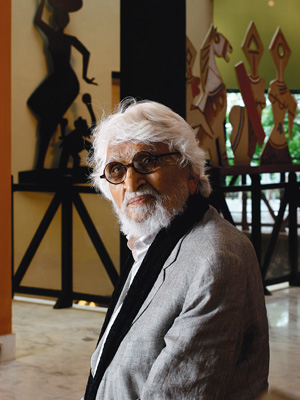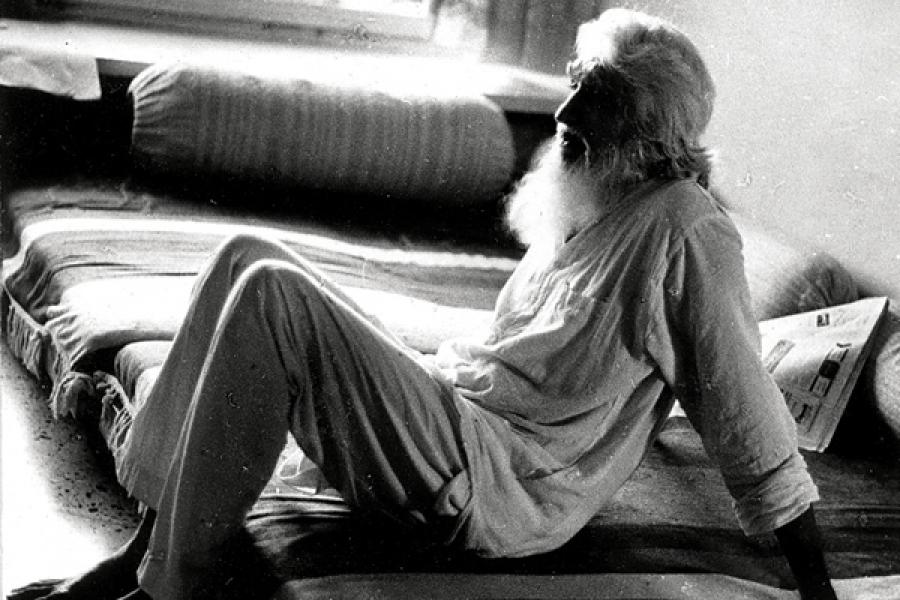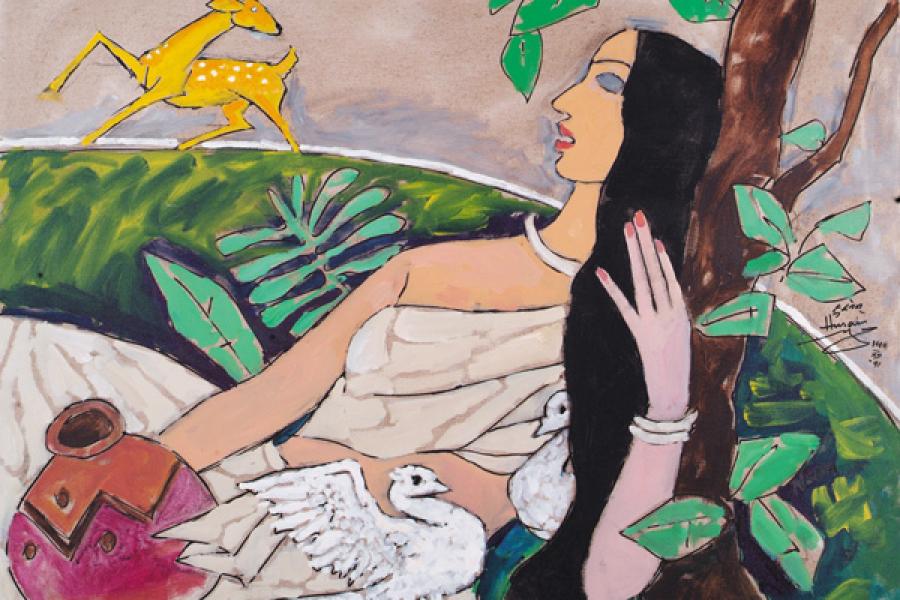
Husain
The life and times of an artist who was Indian first, last and always
The news came in on a Thursday morning (June 9, 2011). Maqbool Fida Husain, India’s most famous artist, had breathed his last in a London hospital. Within minutes, the Twitterverse was awash with wishes that Husain rest in piece. In the hive of hash tags, a large percentage spelt his name wrongly (it isn’t Hussain). Few would have seen his paintings. Many who recognise his distinctive style know his work from reproductions in catalogues and news articles. But whether or not they’ve seen his canvases, everyone knows M.F. Husain.
Husain’s life was like a fairy tale with a sad ending. Born to a poor Muslim family in Pandharpur, Maharashtra, his beginnings were humble. Success took some time to come but when it did, it embraced him tightly. Husain, with his lanky frame, sharp features and white hair and beard, looked like a groovy prophet. His eccentricities, infatuations and experiments made him the talk of towns across the length and breadth of India.
But then, as in every fairy tale, there were reversals. Controversies and accusations swirled around him and increasingly, Husain became infamous in addition to being famous. He was accused of obscenity, disrespecting religious faith, cowardice and finally, when he decided to become a citizen of Qatar, betrayal. But despite all this, Husain remained an icon of Indian art till the end of his days. He was loved, hated, admired, envied but he was never dismissed from public memory.
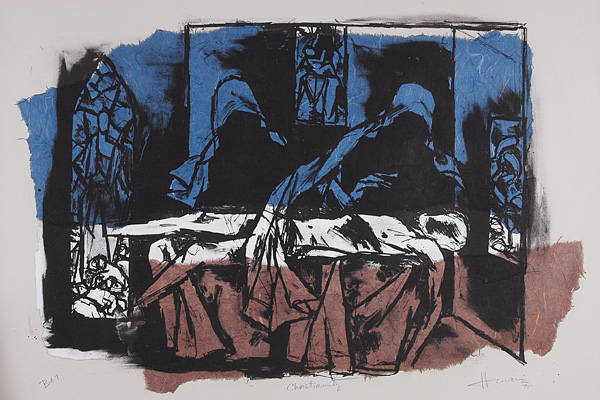
Pieta Themed Husain’s Christianity, Litho Print, 1995Everyone who met him has a story. Shah Rukh Khan remembers having to cajole the manager of a Chinese restaurant in London because Husain had painted on a plate and wanted to now gift the painting to Khan, while the manager couldn’t let dinnerware leave the restaurant premises. A former All India Radio producer’s outstanding memory is of waiting for Husain in his living room — the artist said he’d drink some water and then come back to record an interview — only to eventually learn he’d snuck out of the back door and was on his way to catch a flight to Europe.
But with his penchant for making a news flash, one didn’t have to know Husain to feel a sense of familiarity with the artist. Looking back upon his many public stunts and experiments, like his public adoration for Bollywood actress Madhuri Dixit in the 1990s, it’s obvious that Husain was constantly trying to connect with a wide range of people. The results were mixed. His fascination for Dixit, and later Tabu and Amrita Rao, gave him a reputation of vague lechery for articulating how he found these women, who were young enough to be his daughters, attractive.
But when Husain’s movies were released, all those expecting an ogle project by a randy old man would have been disappointed. Regardless of whether or not one is convinced by Husain’s notion of storytelling, both Gaja Gamini and Meenaxi: A Tale of Three Cities show unusual imagery and a strange mix of poetry and imagination.
There had always been an intriguing blend of mischief and seriousness in Husain’s antics. Back in 1960, well before the idea of installations had come to India, Husain had placed his car inside Mumbai’s Jehangir Art Gallery and then painted on it. In the 1980s, he began walking barefoot. When the Calcutta Club refused to let him enter because its dress code demands guests wear shoes, his campaign for foot freedom cemented his reputation of being a Bohemian artist but also pointed out the club’s outdated colonial etiquette.
When he announced his “joint performance” with classical music maestro Pandit Bhimsen Joshi, people were curious to see what would transpire. On one hand, Husain was giving the crowd a show that was unlike anything they had seen. But he was also looking to contemporise the tradition of visualising a raga, a tradition that had inspired important works of historical Indian art like the Ragamala paintings.
Husain had a talent for being able to arouse curiosity. It was almost as if he was testing himself and his audience with his little spectacles. Crowds gathered in Kolkata to watch him paint six goddesses in six days in public. Once he finished the paintings, he poured white paint over the canvases, which must have seemed very avant-garde in the 1980s. Today, it’s easily categorised as a performance art piece that looks at the process of creating art, its fragility and its impermanence.
In his paintings, Husain made a concerted effort to bring pop culture into his canvases but not in a kitschy way. His canvases showed common life — a Mohun Bagan football match in Kolkata, the allure of Dixit’s curvaceous figure, Indira Gandhi’s take-no-prisoners approach in the Emergency era — as high art. Husain’s paintings were accessible, even if in later years their symbolism became too obvious on many occasions. They emphasised the idea that the art didn’t have to be esoteric. His paintings did not belong only in salons, galleries and museums. At the same time, just because a painting was inspired by simple, sensual pleasures or agonies, it didn’t have to be any less nuanced than an erudite work if it was well conceived.
Husain had been self-conscious about his worldview and education since his early years as an artist. He came to Mumbai from Indore as a 19 year-old, determined to become a painter. It would take 18 years of anonymity and hardship in Mumbai before Husain had his first glimpse of recognition. In 1947, Husain submitted a painting for the annual Bombay Art Society exhibition. There he met F.N. Souza who then introduced him to S.H. Raza and K.H. Ara.
The four of them formed the Progressive Artists Group. The collective didn’t last very long, because both Souza and Raza went abroad to pursue their artistic careers. However, all four developed distinctive styles that redefined Indian art and remain among the most celebrated of Indian artists, both in terms of critical appreciation and auction prices. They also paved the way for a second generation that included brilliant artists like V.S. Gaitonde and Tyeb Mehta.
The PAG mandate was to break away from the dreamy romantic nationalism of the Bengal School and establish a modern Indian artistic vocabulary. They blithely rejected Amrita Sher-Gil, choosing instead to create something that was rooted in India.
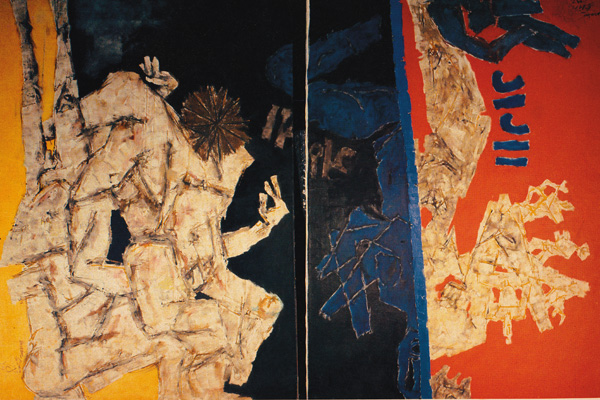
Battle of Ganga and Jamuna An Oil on Canvas diptych from his Mahabharata series
No one agreed with anyone else, but in that atmosphere of impassioned debate Husain was repeatedly made aware of the fact that he didn’t have the Westernised education that people like Souza and Akbar Padamsee had. He hadn’t read the books or seen the films that were often the subject of discussion. Most of his experiences were far less cosmopolitan: Ramlila fairs, listening to tales from Hindu epics from friends, hearing couplets of Urdu poetry from his uncle. However, rather than unlearn all this, Husain wanted to incorporate them into things he was being exposed to by his new friends.
Initially, Husain was the least-known of the PAG quartet. He spent the 1940s experimenting with different ideas, feeling his way around Western modern art and Indian artistic traditions to see what resonated with him. Slowly, he pieced together elements from far-flung traditions: The Expressionist love for using intense colours in a non-naturalistic way; the postures of the human figure in art from the Chola and Gupta periods; the colour palette of Basohli paintings; the clean angularity of Cubism; the bold sensuousness of folk art traditions of central and Western India.
The 1950s and 1960s were Husain’s best years. His paintings from this time are charged with energy, passion and a superb sense of restraint. Nothing is obvious and yet the emotions underpinning the paintings are palpable.
In 1956, he painted “Between the Spider and the Lamp”, which he would later go on to call his “Guernica”. It’s an outstanding painting, rife with mystery and doesn’t feature anything that would incense conservatives. Five women stand next to one another. A spider dangles at the bottom of the painting and a lamp is perched on one of the women’s heads. Bold lines, brilliant colours and superb composition make this one of Husain’s strongest works. There’s a wonderful sense of symmetry in the painting. The spider’s shape recalls the flame inside the lamp. The women have a solidity and strength to them. The most intriguing part about the painting is that Husain doesn’t reveal what the women are doing or why they’re together. The script above them is mysterious gibberish and reveals nothing. “Between the Spider and the Lamp” shows every one of Husain’s strengths: His draughtsmanship, his sense of drama, his eye for the geometry in a scene and his fantastic sense of colour.
One of Husain’s most famous paintings from his later years, especially after the 2008 Delhi High Court verdict that cleared him of charges of obscenity, is “Bharat Mata”. Painted in 2005, it has an incredible raw energy to it. The lines look like knife cuts, particularly the ones that make up the female body bent uncomfortably to mime India’s geographic contours. Her flesh, or the land, is a bloody red. Accents of white, like the chakra, emphasise the reds and dark shadows in the painting. Her eye, hollowed cheek, flared nostril and parted lips are slashed upon her skin. Contorted, gasping and powerful, this is a passionate India that has suffered and survived wars and violence.
When “Bharat Mata” was included in an auction in 2006, members of the Hindu Janajagruti Samiti and the Vishwa Hindu Parishad protested that the painting was obscene and disrespectful because it showed India as a naked woman. Husain tried to defuse tensions with an apology but a petition was filed nonetheless.
This wasn’t the first time Husain had incurred the wrath of Hindu fundamentalists.
It had started back in the mid-1990s when a magazine printed a sketch Husain had made in the ’70s of Saraswati, the Hindu goddess of learning. It was a simple black and white drawing, made up of the strong lines that were Husain’s trademark.
For Hindu right-wingers, however, the sketch was entirely too colourful in a very different sense: Husain, a Muslim artist, had drawn Saraswati, a Hindu goddess, as a nude woman. He was demeaning the goddess by turning her into a sex object, they protested. Never mind that Hindu artists have depicted Hindu goddesses as nudes for centuries; that Husain always painted a Ganesha before beginning a painting; or that the protestors’ logic showed more about their own ignorance and attitude towards women.
The tag of being an anti-Hindu artist was pinned upon Husain and by the time he left India in 2005, there were 900-odd cases registered against him.
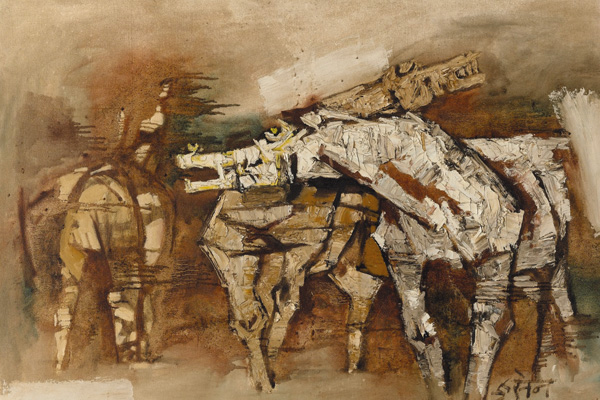
The Famous Horses Husain is known for his horse paintings. Above is his work Bewildered BrownIn 2008, the Delhi High Court sensibly ruled that “Bharat Mata” was not offensive in any way. In its judgement, the bench evinced the opinion that Husain “deserves to be in his home, painting his canvases”. Unfortunately, it was a case of too little too late. Husain, then 92, didn’t have the heart to live with the fear of arrest and violence (in 2006, a fanatical Hindu group had offered a reward of $11.5 million for his head).
In 2010, Husain decided to surrender his Indian passport and become a citizen of Qatar. India was shocked. No one had imagined that Husain would feel compelled to leave India. He was the artist who had not left when so many others had. He had always been anchored in Indian traditions and lore. Yet the same Husain, who loved chai at Mumbai’s Irani cafes and the meetha paan at George Paan Shop in Pune, had surrendered his Indian passport. Hindu fundamentalists crowed that this was proof that Husain had never been a true Indian or a patriot.
It’s a bizarre accusation to level at the man who created a modern Indian vocabulary for art and whose oeuvre is a celebration of Indian culture across the ages. Regardless of the fact that Husain is on paper a Qatari, Husain’s sense of belonging, through both his art and his antics, was with India.
Look at his work — the amazing paintings of horses, the representations of Hindu epics or his amazingly expressive human forms inspired by the sculptures from the Chola and Gupta periods — without which contemporary Indian art couldn’t have had as strong a sense of the complexities of
visualising modern India. Consider the fact that no other figure from Indian art has captivated the masses and elite alike. It becomes obvious then that, no matter what any fundamentalists say or where he is buried, M.F. Husain will always be the quintessential Indian artist.
(This story appears in the 01 July, 2011 issue of Forbes India. To visit our Archives, click here.)
-
 Vijayprakash
VijayprakashThe art is a "Maqbul-feeling" in a "Fidaa-mode" to "Hussain".
on Jun 26, 2011 -
 Geetha
GeethaThy Art is where thine Heart is! Thank you for this very well-written article on the sublime art of a maverick artist who was truly an Indian at heart.
on Jun 25, 2011
